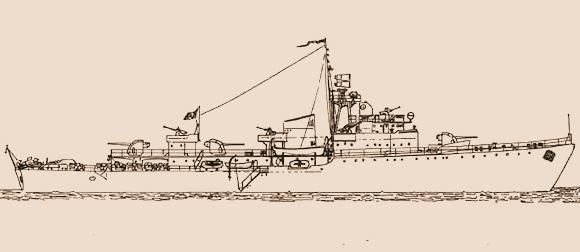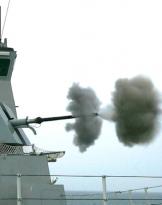In July 1942 the OTO shipyard in Livorno proposed to the Italian Royal Navy the project of an innovative escort unit with a prevalent anti-submarine and anti-area purpose. The accompanying report was exhaustive and accompanied by a beautiful model, showing that the company was very interested in its acceptance.
The proposal was for a 1.260-ton “escort gunship”, capable of reaching a speed of 24 knots, and with a crew of 8 officers and 126 non-commissioned officers and sailors. This type of unit was aimed at fully replacing squad destroyers in escorting convoys, so as to be able to reserve them for escorting duties of the larger units. At the same time they could have been an improvement on the excellent corvettes Seagull under construction.
To allow him the optimal performance of escort duties, a particularly heavy and complete armament was provided, with artillery consisting of three 135/45 guns, a caliber deemed necessary to face enemy destroyers (in the following photo 135/45 guns embarked on the Garibaldi in the 60s), and six of 37/54 (replaceable with as many coupled systems of 20). For the direction of the shot, a turret with a three-meter range finder, an GUFO radiotelemeter, and two APGs (General Targeting Apparatus, ed.) At night were envisaged.
 The antisubmarine armament would have been based on two Gatteschi 7-trolley multiple bombers, equipped with 56 200 kg BTGs as well as eight German type cartridge bombers with 48 180 kg btg, and a towing torpedo. An echogoniometer was provided for the discovery.
The antisubmarine armament would have been based on two Gatteschi 7-trolley multiple bombers, equipped with 56 200 kg BTGs as well as eight German type cartridge bombers with 48 180 kg btg, and a towing torpedo. An echogoniometer was provided for the discovery.
For self-defense the unit would have been equipped with two fixed 450 mm underwater launch tubes, aimed in retreat with four torpedoes, and two fog systems. To counteract the minefields, the unit would have had to be equipped with running dredging equipment.
To ensure a speed of 24 knots. with a range of more than 15.000 miles at 16 knots, a diesel engine was chosen which, moreover, due to its quick set-up times compared to a turbine engine, was the ideal choice for a spare unit. From a seafaring point of view, a high freeboard had been designed, which guaranteed good seaworthiness, and there were four propellers and two rudders which together gave good maneuverability.
It had a reinforced bow with a saw wheel that replaced the antisubmarine spur many of the escort units were equipped with. On the unit there were special large rooms equipped with toilets to accommodate castaways, prisoners or troops for a maximum capacity of 200 men and an equipped infirmary capable of 14 beds. An interesting novelty was also the provision of a fixed accommodation for the towing, an operation to which the escort units were often called to rescue damaged units. The shipyard also proposed a project to use this hull for a small passenger ship and plans to derive from the Seagull of motor ships for the lighthouse service.
The project, advanced enough to be tested at the naval basin in Rome, described a modern, innovative unit for those times. The only note that could be addressed was the adoption of exclusively anti-ship guns while more useful would have been dual-purpose guns, even lighter like 90/50, with adequate direction of fire. Nothing is known about the context and the follow-up that this proposal had, however, after the first 60 corvettes, according to some sources, another ten planned during 43 should have followed (of which the first three would actually have been ordered to shipyards OTO of Livorno). In reality, due to the armistice of 1943, the works were abandoned.
Given the tenor of the OTO report that accompanied the project, particular emphasis was placed on emphasizing the superiority of this future class over the corvettes, suggesting that it was intended to replace, in whole or in part, the ordering of this supplementary series of Corvette with higher class (and cost) units. This would explain the unusually high caliber artillery proposal for an escort, design and production unit of the OTO itself.
This project, due to the well-known armistice events, did not materialize but some of its lines of study were found in the Italian escort units that were built up to the 60s.
Gianluca Bertozzi
(article originally published on http://www.ocean4future.org)
Sources:
The AS 450 project by Erminio Bagnasco military history magazine n 7 April 1994
The Italian warships 1940-1945 by Erminio Bagnasco and alii.












